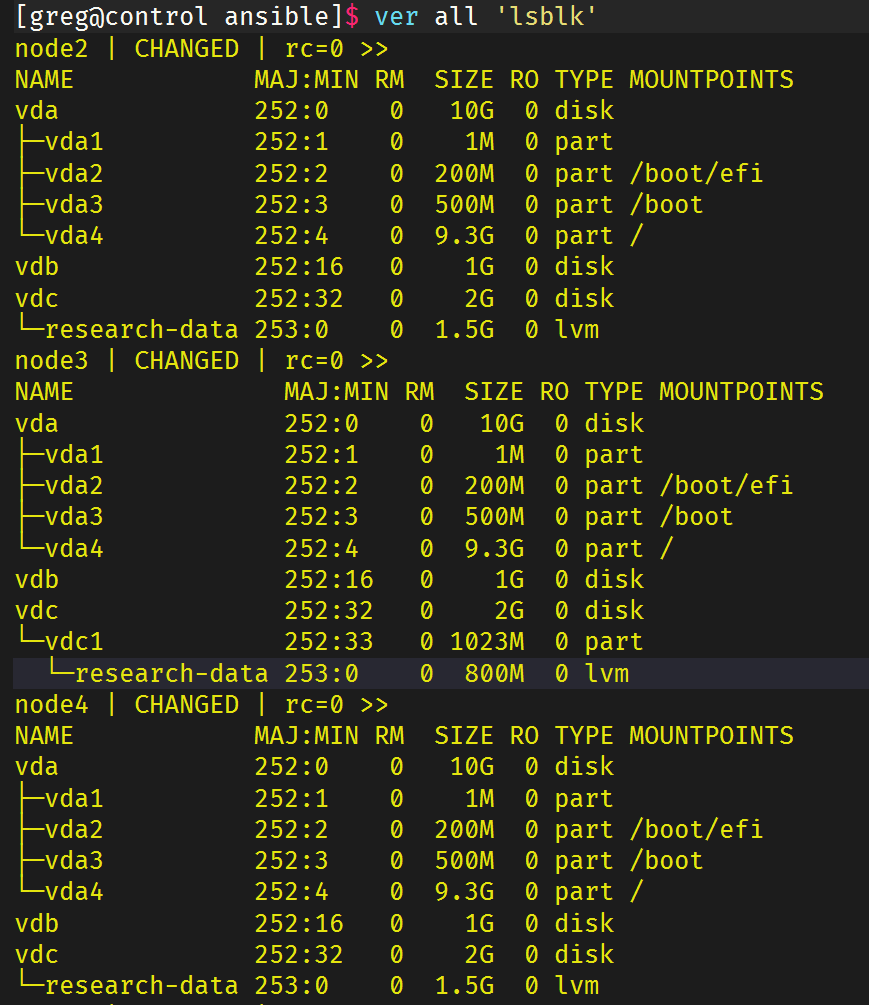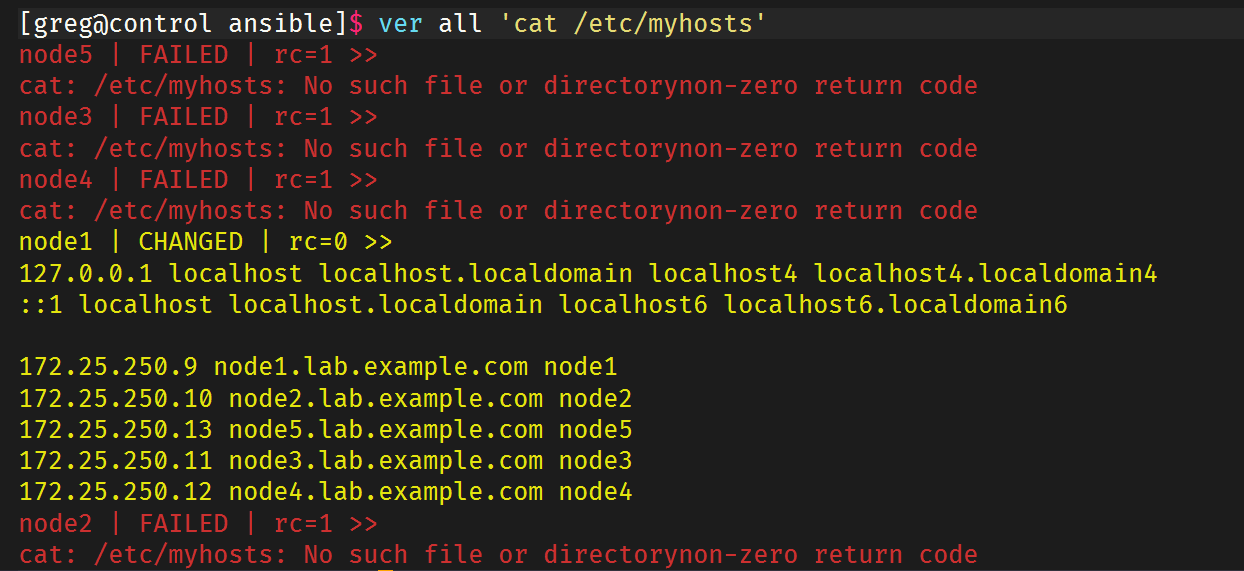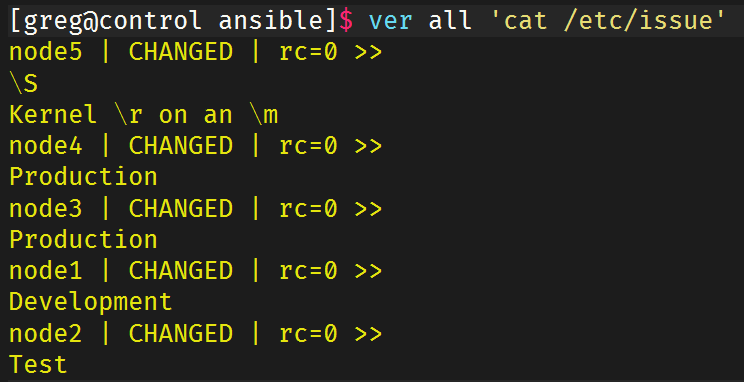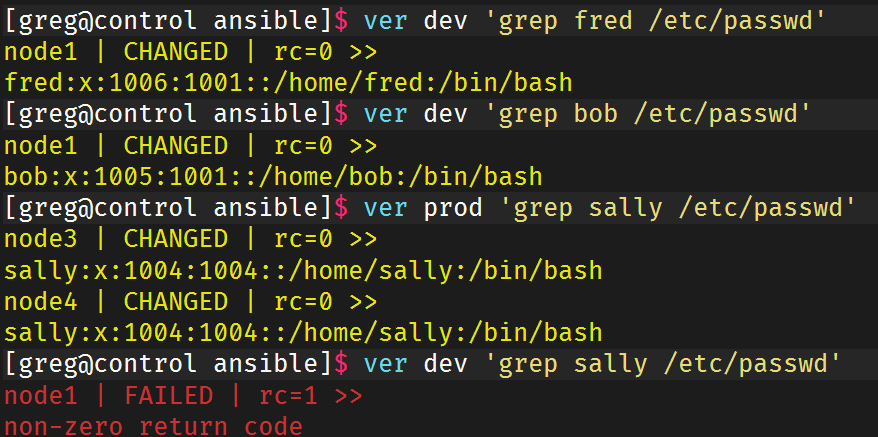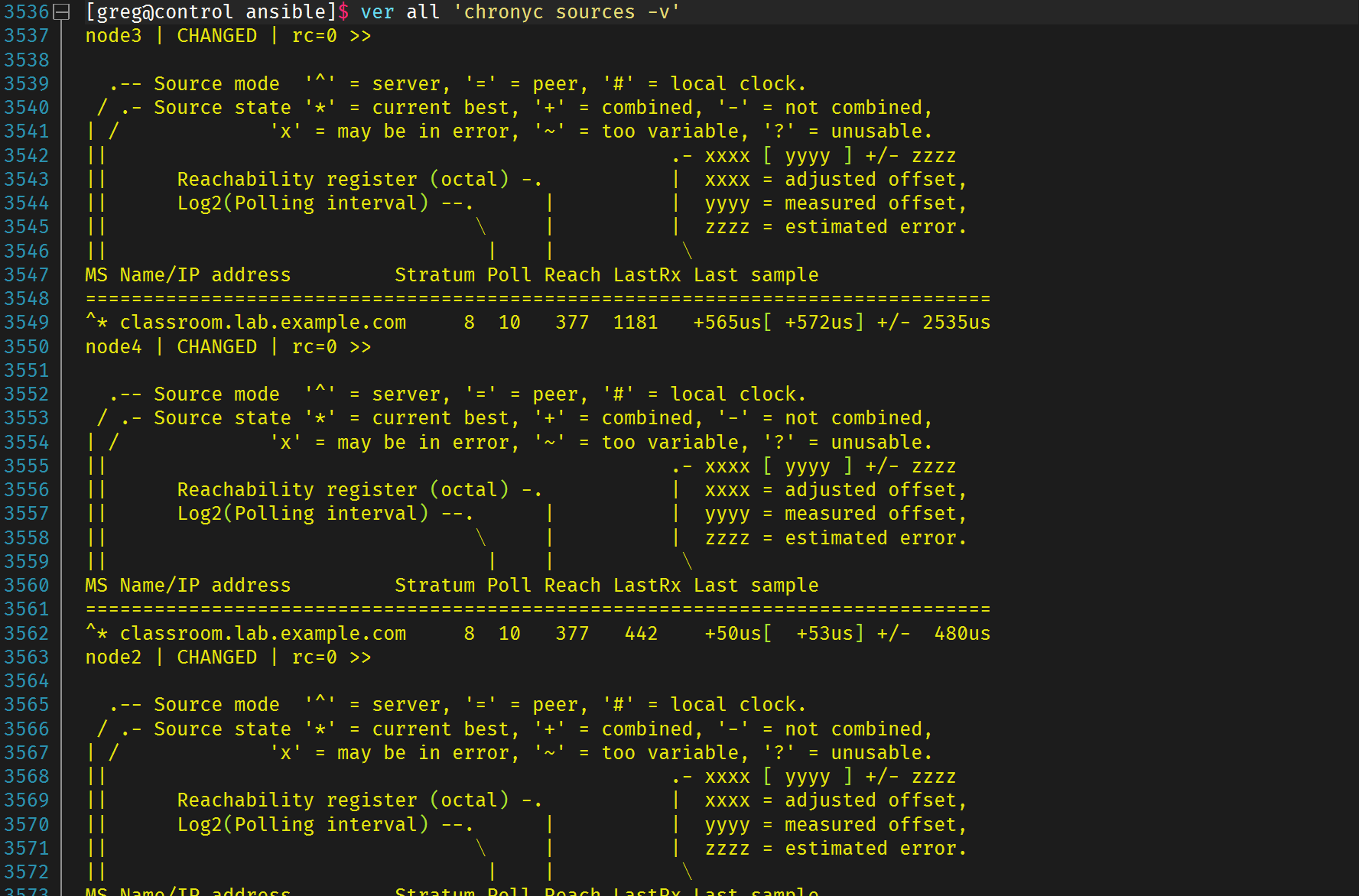rhce9认证题目
提高高频操作效率小tips:
1 安装和配置 Ansible
在控制节点 control 上安装和配置 Ansible:
- 安装所需的软件包
- 创建静态清单文件
/home/greg/ansible/inventory,满足以下要求:
- node1 属于 dev 主机组
- node2 属于 test 主机组
- node3 和 node4 属于 prod 主机组
- node5 属于 balancers 主机组
- prod 组是 webservers 主机组的成员
- 创建配置文件
/home/greg/ansible/ansible.cfg,满足以下要求:
- 主机清单文件为
/home/greg/ansible/inventory- playbook 使用的角色位置包括
/home/greg/ansible/roles- 自定义 collection 目录在
/home/greg/ansible/mycollection
-
考试正式开始,使用greg用户连接到control节点,安装ansible
1 2
ssh greg@control yum install ansible ansible-navigator -y
-
在家目录下创建一个ansible目录,考试的所有操作在本文件夹中进行,即/home/greg/ansible,顺便创建题目需要的roles文件夹和mycollection文件夹
1 2 3
mkdir ansible mkdir /home/greg/ansible/roles mkdir /home/greg/ansible/mycollection
-
创建inventory文件
1 2 3 4 5 6 7 8 9 10 11
[dev] node1 [test] node2 [prod] node3 node4 [balancers] node5 [webservers:children] prod
-
使用ansible-init初始化配置文件
1
ansible-config init --disabled > ansible.cfg
-
修改我们需要的配置
1 2 3 4 5 6
inventory=/home/greg/ansible/inventory # 配置主机文件路径 collections_path=/home/greg/ansible/mycollection:/usr/share/ansible/collections # 配置collection路径 roles_path=/home/greg/ansible/roles:/usr/share/ansible/roles:/etc/ansible/roles # 配置roles路径 host_key_checking=False # 跳过证书检查 remote_user=greg # 指定执行ansible命令的用户 become=True # 有些命令例如yum需要提权
-
验证
1 2
ansible-inventory --graph ansible all -m ping
2 配置系统使用默认存储库
创建 playbook
/home/greg/ansible/yum_repo.yml,在各受管节点上安装 yum 存储库:
- 存储库1:
- 名称:EX294_BASE
- 描述:EX294 base software
- 基础 URL:
http://content/rhel9.0/x86_64/dvd/BaseOS- GPG 签名检查:启用
- GPG 密钥 URL:
http://content/rhel9.0/x86_64/dvd/RPM-GPG-KEY-redhat-release- 存储库状态:启用
- 存储库2:
- 名称:EX294_STREAM
- 描述:EX294 stream software
- 基础 URL:
http://content/rhel9.0/x86_64/dvd/AppStream- GPG 签名检查:启用
- GPG 密钥 URL:
http://content/rhel9.0/x86_64/dvd/RPM-GPG-KEY-redhat-release- 存储库状态:启用
-
查询文档
1 2 3 4 5 6
# 添加存储库 - name: Add repository ansible.builtin.yum_repository: name: epel description: EPEL YUM repo baseurl: https://download.fedoraproject.org/pub/epel/$releasever/$basearch/
-
配置文件
1 2 3 4 5 6 7 8 9 10 11 12 13 14 15 16 17 18 19 20
--- - name: yum_repository hosts: all tasks: - name: Add repository1 ansible.builtin.yum_repository: name: EX294_BASE description: EX294 base software baseurl: http://content/rhel9.0/x86_64/dvd/BaseOS gpgcheck: yes gpgkey: http://content/rhel9.0/x86_64/dvd/RPM-GPG-KEY-redhat-release enabled: yes - name: Add repository2 ansible.builtin.yum_repository: name: EX294_STREAM description: EX294 stream software baseurl: http://content/rhel9.0/x86_64/dvd/AppStream gpgcheck: yes gpgkey: http://content/rhel9.0/x86_64/dvd/RPM-GPG-KEY-redhat-release enabled: yes
3 安装软件包
创建 playbook
/home/greg/ansible/packages.yml:
- 将 php 和 mariadb 软件包安装到 dev、test 和 prod 主机组中的主机
- 将 RPM Development Tools 软件包组安装到 dev 主机组中的主机
- 将 dev 主机组中主机上的所有软件包更新为最新版本
-
查询文档
1 2 3 4 5 6 7 8 9 10 11 12 13 14 15 16 17 18 19 20
# 安装一组软件包示例 - name: Install a list of packages with a list variable ansible.builtin.yum: name: "{{ packages }}" vars: packages: - httpd - httpd-tools # 安装软件包示例 - name: Install the 'Development tools' package group ansible.builtin.yum: name: "@Development tools" state: present # 更新所有软件包 - name: Upgrade all packages ansible.builtin.yum: name: '*' state: latest
-
配置文件
1 2 3 4 5 6 7 8 9 10 11 12 13 14 15 16 17 18 19 20 21 22 23
--- - name: packages_1 hosts: dev,test,prod tasks: - name: Install a list of packages with a list variable ansible.builtin.yum: name: "{{ packages }}" vars: packages: - php - mariadb - name: packages_2 hosts: dev tasks: - name: Install the 'RPM Development Tools' package group ansible.builtin.yum: name: "@RPM Development Tools" state: present - name: Upgrade all packages ansible.builtin.yum: name: '*' state: latest
4 使用 RHEL 系统角色
安装 RHEL 系统角色软件包,并创建 playbook
/home/greg/ansible/selinux.yml:
- 在所有受管节点上运行
- 使用 selinux 角色
- 配置被管理节点的 SELinux 为 enforcing 模式
-
安装系统角色
1 2
yum search role yum install rhel-system-roles -y
-
使用角色
1 2
cp /usr/share/doc/rhel-system-roles/selinux/example-selinux-playbook.yml /home/greg/ansible/selinux.yml ansible-playbook selinux.yml -
验证
5 配置 collection
将以下 3 个collection安装到
/home/greg/ansible/mycollection目录中:
http://classroom/materials/redhat-insights-1.0.7.tar.gzhttp://classroom/materials/community-general-5.5.0.tar.gzhttp://classroom/materials/redhat-rhel_system_roles-1.19.3.tar.gz
-
创建配置
1 2 3 4 5
--- collections: - name: http://classroom/materials/redhat-insights-1.0.7.tar.gz - name: http://classroom/materials/community-general-5.5.0.tar.gz - name: http://classroom/materials/redhat-rhel_system_roles-1.19.3.tar.gz
-
安装角色
1
ansible-galaxy collection install -r requirements.yml -p /home/greg/ansible/mycollection/
-
验证
6 使用 Ansible Galaxy 安装角色
使用 Ansible Galaxy 和文件
/home/greg/ansible/roles/requirements.yml,从以下 URL 下载角色并安装到/home/greg/ansible/roles:
http://classroom/materials/haproxy.tar(角色名:balancer)http://classroom/materials/phpinfo.tar(角色名:phpinfo)
-
创建配置
1 2 3 4 5
--- - src: http://classroom/materials/haproxy.tar name: balancer - src: http://classroom/materials/phpinfo.tar name: phpinfo
-
安装角色
1
ansible-galaxy install -r /home/greg/ansible/roles/requirements.yml -p /home/greg/ansible/roles
-
验证
7 创建和使用角色
在
/home/greg/ansible/roles中创建名为 apache 的角色,要求:
安装并启用 httpd 服务
启用防火墙并允许访问 Web 服务器
使用模板文件
index.html.j2创建/var/www/html/index.html,内容为:
(HOSTNAME 为完全限定域名,IPADDRESS 为 IP 地址)
创建 playbook
/home/greg/ansible/apache.yml:
- 在 webservers 主机组中的主机上运行并使用 apache 角色
-
初始化一个角色
1
ansible-galaxy role init apache --init-path /home/greg/ansible/roles/ -
查询文档
1 2 3 4 5 6 7 8 9 10 11 12 13 14 15 16 17 18 19 20 21 22 23 24 25 26 27 28 29 30 31 32 33
# 安装httpd | doc yum 10 - name: Install the latest version of Apache ansible.builtin.yum: name: httpd state: latest # 确保httpd启动 | doc systemd 10 | 注意要添加enabled: yes - name: Make sure a service unit is running ansible.builtin.systemd: state: started name: httpd # 确保防⽕墙启动 | doc systemd 10 | 注意要添加enabled: yes - name: Make sure a service unit is running ansible.builtin.systemd: state: started name: httpd # 添加防火墙规则 | 注意添加immediate: yes - name: permit traffic in default zone for https service ansible.posix.firewalld: service: https permanent: yes state: enabled # 模板文件 - name: Template a file to /etc/file.conf ansible.builtin.template: src: /mytemplates/foo.j2 dest: /etc/file.conf owner: bin group: wheel mode: '0644'
-
创建index.html.j2文件
1
Welcome to {{ ansible_nodename }} on {{ ansible_default_ipv4.address }}
-
编辑角色文件
1 2 3 4 5 6 7 8 9 10 11 12 13 14 15 16 17 18 19 20 21 22 23 24 25 26 27 28 29 30
--- - name: Install the latest version of Apache ansible.builtin.yum: name: httpd state: present - name: Make sure a service unit is running ansible.builtin.systemd: name: httpd state: started enabled: yes - name: Make sure a service unit is running ansible.builtin.systemd: state: started name: firewalld enabled: yes - name: permit traffic in default zone for https service ansible.posix.firewalld: service: http permanent: yes state: enabled immediate: yes - name: Template a file ansible.builtin.template: src: index.html.j2 dest: /var/www/html/index.html setype: httpd_sys_content_t
-
创建配置文件
1 2 3 4 5
--- - name: apache hosts: webservers roles: - apache -
验证
8 从 Ansible Galaxy 使用角色
创建 playbook
/home/greg/ansible/roles.yml:
- 在 balancers 主机组中的主机上运行并使用 balancer 角色,配置负载均衡服务
- 在 webservers 主机组中的主机上运行并使用 phpinfo 角色,确保:
- 访问
/hello.php输出Hello PHP World from FQDN- 显示 PHP 配置信息
-
配置文件
1 2 3 4 5 6 7 8 9
--- - name: roles1 hosts: balancers roles: - balancer - name: roles2 hosts: webservers roles: - phpinfo -
验证
9 创建和使用逻辑卷
创建 playbook
/home/greg/ansible/lv.yml,在所有受管节点上执行以下任务:
- 在 research 卷组中创建名为 data、大小为 1500 MiB 的逻辑卷
- 使用 ext4 文件系统格式化逻辑卷
- 若无法创建 1500 MiB,则显示错误并改为创建 800 MiB
- 若卷组 research 不存在,显示错误信息
- 不挂载逻辑卷
-
查看文档
1 2 3 4 5 6 7 8 9 10 11 12 13
# 创建逻辑卷 - name: Create a logical volume of 512m community.general.lvol: vg: firefly lv: test size: 512 # 格式化文件系统 - name: Create a ext4 filesystem on /dev/sdb1 and check disk blocks community.general.filesystem: fstype: ext4 dev: /dev/sdb1 opts: -cc
-
配置文件
1 2 3 4 5 6 7 8 9 10 11 12 13 14 15 16 17 18 19 20 21 22 23 24 25 26 27 28 29 30 31 32 33
--- - name: lv hosts: all tasks: - name: Check if vg exist block: - name: Create a logical volume of 1500MiB community.general.lvol: vg: research lv: data size: 1500m - name: Create a ext4 filesystem community.general.filesystem: fstype: ext4 dev: /dev/research/data rescue: - name: Message ansible.builtin.debug: msg: Could not create logical volume of that size - name: Create a logical volume of 800MiB community.general.lvol: vg: research lv: data size: 800m - name: Create a ext4 filesystem community.general.filesystem: fstype: ext4 dev: /dev/research/data when: ansible_facts.lvm.vgs.research is defined - name: Message ansible.builtin.debug: msg: Volume group done not exist when: ansible_facts.lvm.vgs.research is not defined
-
验证
10 生成主机文件
- 从
http://classroom/materials/hosts.j2下载模板到/home/greg/ansible- 修改模板,使其能为每个清单主机生成一行
/etc/hosts格式的内容- 从
http://classroom/materials/hosts.yml下载 playbook 到/home/greg/ansible,使用模板在 dev 主机组中的主机上生成文件/etc/myhosts
-
下载文件
1
wget http://classroom/materials/hosts.j2
-
查找文档
1 2 3 4 5 6 7 8
# 模板文件 - name: Template a file to /etc/file.conf ansible.builtin.template: src: /mytemplates/foo.j2 dest: /etc/file.conf owner: bin group: wheel mode: '0644'
-
模板文件
1 2 3
{% for i in groups.all %} {{ hostvars[i].ansible_facts.default_ipv4.address }} {{ hostvars[i].ansible_facts.nodename }} {{ hostvars[i].ansible_facts.hostname }} {% endfor %}
-
配置文件
1 2 3 4 5 6 7 8 9
--- - name: hosts hosts: all tasks: - name: Template a file ansible.builtin.template: src: /home/greg/ansible/hosts.j2 dest: /etc/myhosts when: inventory_hostname in groups.dev
-
验证
11 修改文件内容
创建 playbook
/home/greg/ansible/issue.yml,在所有清单主机上运行:
- 将
/etc/issue内容替换为:
- dev 主机组:
Development- test 主机组:
Test- prod 主机组:
Production
-
查看文档
1 2 3 4 5
# 使用一行作为文件内容 - name: Copy using inline content ansible.builtin.copy: content: '# This file was moved to /etc/other.conf' dest: /etc/mine.conf
-
配置文件
1 2 3 4 5 6 7 8 9 10 11 12 13 14 15 16 17 18 19 20 21
--- - name: issue hosts: all tasks: - name: Copy using inline content ansible.builtin.copy: content: 'Development' dest: /etc/issue when: inventory_hostname in groups.dev - name: Copy using inline content ansible.builtin.copy: content: 'Test' dest: /etc/issue when: inventory_hostname in groups.test - name: Copy using inline content ansible.builtin.copy: content: 'Production' dest: /etc/issue when: inventory_hostname in groups.prod
-
验证
12 创建 Web 内容目录
创建 playbook
/home/greg/ansible/webcontent.yml,在 dev 主机组中的主机上:
- 创建目录
/webdev:
- 所有者为 webdev 组
- 权限:
rwxrwsr-x- 设置组 ID
- 创建符号链接
/var/www/html/webdev指向/webdev- 创建文件
/webdev/index.html,内容为Development
-
查看文档
1 2 3 4 5 6 7 8 9 10 11 12 13 14 15 16 17 18 19 20 21
# 创建文件夹 - name: Create a directory if it does not exist ansible.builtin.file: path: /etc/some_directory state: directory mode: '0755' # 创建符号链接 - name: Create a symbolic link ansible.builtin.file: src: /file/to/link/to dest: /path/to/symlink owner: foo group: foo state: link # 使用一行作为文件内容 - name: Copy using inline content ansible.builtin.copy: content: '# This file was moved to /etc/other.conf' dest: /etc/mine.conf
-
配置文件
1 2 3 4 5 6 7 8 9 10 11 12 13 14 15 16 17 18 19 20 21 22 23 24
--- - name: webcontent hosts: dev roles: - apache tasks: - name: Create a directory if it does not exist ansible.builtin.file: path: /webdev state: directory group: webdev mode: '2775' - name: Create a symbolic link ansible.builtin.file: src: /webdev dest: /var/www/html/webdev state: link - name: Copy using inline content ansible.builtin.copy: content: 'Development' dest: /webdev/index.html setype: httpd_sys_content_t -
验证
13 生成硬件报告
创建 playbook
/home/greg/ansible/hwreport.yml,在所有受管节点上生成/root/hwreport.txt,包含:
- 清单主机名称
- 总内存大小(MB)
- BIOS 版本
- 磁盘设备 vda 和 vdb 的大小
- 每行格式为
key=value- 若硬件不存在,值为
NONE- 从
http://classroom/materials/hwreport.empty下载初始模板
-
查询文档
1 2 3 4 5 6 7 8 9 10 11 12 13
# 下载文件 - name: Download foo.conf ansible.builtin.get_url: url: http://example.com/path/file.conf dest: /etc/foo.conf mode: '0440' # 编辑某行 - name: Ensure SELinux is set to enforcing mode ansible.builtin.lineinfile: path: /etc/selinux/config regexp: '^SELINUX=' line: SELINUX=enforcing
-
配置文件
1 2 3 4 5 6 7 8 9 10 11 12 13 14 15 16 17 18 19 20 21 22 23 24 25 26 27 28 29 30 31 32 33 34 35 36 37 38
--- - name: hwreport hosts: all tasks: - name: Download hwreport.empty ansible.builtin.get_url: url: http://classroom/materials/hwreport.empty dest: /root/hwreport.txt - name: Replace ansible.builtin.lineinfile: path: /root/hwreport.txt regexp: '^HOST=' line: HOST={{ ansible_hostname }} - name: Replace ansible.builtin.lineinfile: path: /root/hwreport.txt regexp: '^MEMORY=' line: MEMORY={{ ansible_memtotal_mb }} - name: Replace ansible.builtin.lineinfile: path: /root/hwreport.txt regexp: '^BIOS=' line: BIOS={{ ansible_bios_version }} - name: Replace ansible.builtin.lineinfile: path: /root/hwreport.txt regexp: '^DISK_SIZE_VDA=' line: DISK_SIZE_VDA={{ ansible_devices.vda.size }} - name: Replace ansible.builtin.lineinfile: path: /root/hwreport.txt regexp: '^DISK_SIZE_VDB' line: DISK_SIZE_VDB={{ ansible_devices.vdb.size | default('NONE',True) }}
-
验证
14 创建密码库
创建 Ansible 库
/home/greg/ansible/locker.yml:
- 变量:
pw_developer:Imadevpw_manager:Imamgr- 加密密码:
whenyouwishuponastar- 密码存储在
/home/greg/ansible/secret.txt
-
创建密码文件
1
echo "whenyouwishuponastar" > /home/greg/ansible/secret.txt
-
修改配置文件
1
vault_password_file=/home/greg/ansible/secret.txt -
创建密码文件
1
ansible-vault create /home/greg/ansible/locker.yml
-
验证
15 创建用户账户
从
http://classroom/materials/user_list.yml下载用户列表,创建 playbook/home/greg/ansible/users.yml:
- developer 用户:
- 在 dev 和 test 主机组中创建
- 密码来自
pw_developer变量- 密码有效期 30 天
- 属于 devops 组
- manager 用户:
- 在 prod 主机组中创建
- 密码来自
pw_manager变量- 密码有效期 30 天
- 属于 opsmgr 组
- 使用密码库
/home/greg/ansible/locker.yml和密码文件/home/greg/ansible/secret.txt
-
下载用户列表文件
1
wget http://classroom/materials/user_list.yml
-
查看文档
1 2 3 4 5 6 7 8 9 10 11 12 13
# 用户组存在 - name: Ensure group "somegroup" exists ansible.builtin.group: name: somegroup state: present # 添加用户 - name: Add the user 'johnd' with a specific uid and a primary group of 'admin' ansible.builtin.user: name: johnd comment: John Doe uid: 1040 group: admin
-
配置文件
1 2 3 4 5 6 7 8 9 10 11 12 13 14 15 16 17 18 19 20 21 22 23 24 25 26 27 28 29 30 31 32 33 34 35 36 37 38
--- - name: users1 hosts: dev,test vars_files: - /home/greg/ansible/user_list.yml - /home/greg/ansible/locker.yml tasks: - name: Ensure group "devops" exists ansible.builtin.group: name: devops state: present - name: Add the user ansible.builtin.user: name: "{{ item.name }}" password: "{{ pw_developer | password_hash('sha512') }}" password_expire_max: 30 group: devops loop: "{{ users }}" when: item.job == "developer" - name: users2 hosts: prod vars_files: - /home/greg/ansible/user_list.yml - /home/greg/ansible/locker.yml tasks: - name: Ensure group "opsmgr" exists ansible.builtin.group: name: opsmgr state: present - name: Add the user ansible.builtin.user: name: "{{ item.name }}" password: "{{ pw_manager | password_hash('sha512') }}" password_expire_max: 30 group: opsmgr loop: "{{ users }}" when: item.job == "manager"
-
验证
16 更新 Ansible 库的密钥
更新现有 Ansible 库
/home/greg/ansible/salaries.yml:
- 从
http://classroom/materials/salaries.yml下载- 当前密码:
insecure8sure- 新密码:
bbs2you9527- 保持加密状态
-
下载密码文件
1
wget http://classroom/materials/salaries.yml
-
修改密钥
1 2 3 4 5
[greg@control ansible]$ ansible-vault rekey salaries.yml --ask-vault-password Vault password: New Vault password: Confirm New Vault password: Rekey successful
-
验证
17 配置 cron 作业
创建 playbook
/home/greg/ansible/cron.yml,在 test 主机组中的主机上:
- 配置 cron 作业,每 2 分钟以用户 natasha 身份运行:
logger "EX200 in progress"
-
查询文档
1 2 3 4 5 6 7
# cron模块 - name: Ensure a job that runs at 2 and 5 exists. Creates an entry like "0 5,2 * * ls -alh > /dev/null" ansible.builtin.cron: name: "check dirs" minute: "0" hour: "5,2" job: "ls -alh > /dev/null"
-
配置文件
1 2 3 4 5 6 7 8 9 10
--- - name: cron hosts: test tasks: - name: Ensure a job ansible.builtin.cron: name: "logger" minute: "*/2" job: 'logger "EX200 in progress"' user: natasha
-
验证
18 使用 TimeSync RHEL 系统角色
安装 RHEL 系统角色软件包,创建 playbook
/home/greg/ansible/timesync.yml:
- 在所有受管节点上运行
- 使用 timesync 角色
- 配置时间服务器为
classroom.lab.example.com
-
配置文件
1 2 3 4 5 6 7 8 9
--- - name: Create NTP hosts: all vars: timesync_ntp_servers: - hostanme: classroom.lab.example.com iburst: yes roles: - rhel-system-roles.timesync
-
验证
19 创建分区
在 balancers 主机上:
- 划分
/dev/vdb1(1500 MiB,若不足则 800 MiB)- 格式化为 ext4
- 挂载到
/newpart1- 若无
/dev/vdb,报错
-
查询文档
1 2 3 4 5 6 7 8 9 10 11 12 13 14 15 16 17 18 19 20 21 22 23 24 25 26 27 28 29 30
# 创建文件夹 - name: Create a directory if it does not exist ansible.builtin.file: path: /etc/some_directory state: directory mode: '0755' # 创建分区 - name: Create a new primary partition with a size of 1GiB community.general.parted: device: /dev/sdb number: 1 state: present part_end: 1GiB # 格式化文件系统 - name: Create a ext4 filesystem on /dev/sdb1 and check disk blocks community.general.filesystem: fstype: ext4 dev: /dev/sdb1 opts: -cc # 挂载文件 - name: Mount an NFS volume ansible.posix.mount: src: 192.168.1.100:/nfs/ssd/shared_data path: /mnt/shared_data opts: rw,sync,hard,intr state: mounted fstype: nfs
-
配置文件
1 2 3 4 5 6 7 8 9 10 11 12 13 14 15 16 17 18 19 20 21 22 23 24 25 26 27 28 29 30 31 32 33 34 35 36 37 38 39 40 41 42 43 44 45 46 47 48 49 50 51 52 53 54 55 56 57 58 59
--- - name: partition hosts: dev tasks: - name: Create a directory ansible.builtin.file: name: /newpart state: directory - block: - name: Create 1500M partition community.general.parted: device: /dev/vdb number: 1 state: present part_end: 1500MiB - name: Create ext4 filesystem community.general.filesystem: fstype: ext4 dev: /dev/vdb1 - name: Mount partition ansible.posix.mount: path: /newpart src: /dev/vdb1 fstype: ext4 state: mounted rescue: - debug: msg: "Could not create 1500M partition, falling back to 800M" - name: Create 800M partition community.general.parted: device: /dev/vdb number: 1 state: present part_end: 800MiB when: ansible_facts.devices.vdb is defined - name: Create ext4 filesystem (800M) community.general.filesystem: fstype: ext4 dev: /dev/vdb1 when: ansible_facts.devices.vdb is defined - name: Mount partition (800M) ansible.posix.mount: path: /newpart src: /dev/vdb1 fstype: ext4 state: mounted when: ansible_facts.devices.vdb is defined always: - debug: msg: "Disk /dev/vdb does not exist" when: ansible_facts.devices.vdb is undefined







